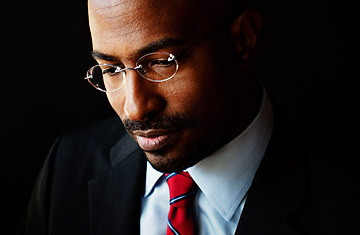
A portrait of Van Jones at his home in the Silver Lake area of Los Angeles, October 23, 2011.
(3 of 4)
It did not take him long to reach some conclusions, which he packaged in a 70-slide PowerPoint presentation that he began showing to the leaders of just about every progressive institution on both coasts. Modern social change, he argued, was driven from the ground up through "meta-branded" movements organized online through social media. The key, he said, was to construct an identity that people from different groups could join without abandoning their own priorities. In the 2008 campaign, the only brand liberals rallied around was Barack Obama. But his election gave liberals the wrong theory of the presidency, Jones came to believe. "Lyndon Johnson wasn't out there leading the civil rights movement," he says. "Abraham Lincoln was not an abolitionist." If liberals wanted change, in other words, they would need a grassroots movement of their own. It would have to be organized around a set of ideals, not any particular person. "We don't want leader-centric movements," Jones said. "We want leader-full movements." Deepak Bhargava, the executive director of one of the left's most active Washington institutions, the Center for Community Change, says Jones' PowerPoint presentation reminded the liberal establishment that it wasn't tied to Obama's struggles. "We were all incredibly taken with the analysis," he said.
In short order, nearly every national progressive group in the U.S. signed on to Jones' effort, pledging to form what the groups called the American Dream Movement. They organized small "Jobs Not Cuts" protests this summer and fall and held hundreds of house parties to draft a broad agenda calling for higher taxes on the wealthy, more government spending to help the unemployed and greater regulation of Wall Street. Jones says he has modeled his movement in part on the organic Tea Party groundswell of 2009, and he steered clear of his old White House contacts as he developed it.
Then something happened that Jones never expected: some young people decided to pitch tents in lower Manhattan. Occupy Wall Street was born.
Will the Movement Behave?
The decision by liberal groups to embrace Occupy was not a foregone conclusion. In the protest's first weeks, much of the establishment left stayed on the sidelines, unsure what to make of the activists camping out beneath skyscrapers. "It was a big question," Jones says. "Will these kids even be there tomorrow? Are these kids going to get violent?"
But Jones pressed the case for championing the new effort. He began to adopt the clear-cut class language of the Occupy protesters, denouncing the "banksters," whom he described as "some of the worst people in the world." He wrote an essay in the Huffington Post addressed to his fellow liberal leaders, titled "Wall Street Protests: Which Side Are You On?" and appeared on HBO's Real Time with Bill Maher to declare how proud he was of the new generation in the streets. "You talk about the Arab Spring," Jones said. "We could be on the verge of an American Autumn."
